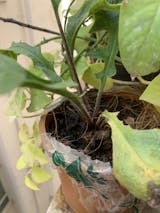Daffodil 'Falconet'
Family
Amaryllidaceae
Origin
Europe
Description
The daffodil is a perennial and grows to about 41 cm (16 inches) in height. Each plant features five or six linear leaves that grow from the bulb and are about 30 cm (12 inches) long. The stem bears one large yellow blossom with a corolla deeply cleft into six lobes and a central bell-shaped crown, or corona, that is frilled at its edges. This trumpet shape contains the stamens and is the flower’s most conspicuous feature.
Brightly colored and strongly fragrant, multiple award-winner Narcissus 'Falconet' bears cheerful clusters of 3-8 flowers per stem, adorned with deep yellow, overlapping petals and bright orange-red cups in mid spring. Because of its strong stem and sweet scent, this Tazetta Daffodil makes excellent cut flowers.
Environment
Daffodil bulbs can be planted in spring, but getting them into the ground in autumn gives them a head start. Rule of thumb says to plant them twice as deep as they are wide. Three to 5 inches is about right. You can add bulb food or bone meal at planting time to get the bulbs off to a good start.
Narcissus love full sun, and six hours or more is imperative. Daffodils will bloom best when given adequate exposure to early spring sunshine! Ideal for warmer climates, it is perfect for indoor forcing.
Most daffodils tolerate a range of soils but grow best in moderately fertile, well-drained soil that is kept moist during the growing season. They are susceptible to rot when kept too wet, so make sure that you plant them in a well-draining spot.
Provide a handful of any general-purpose fertilizer when shoots poke through the ground in early spring. Apply a low-nitrogen, high-potash (potassium) fertilizer after flowering if bulbs are not performing as desired.
After daffodils bloom in the spring, allow the plants to grow until they die off. Do NOT cut down earlier. They need time after blooming to store energy in the bulbs for next year’s bloom.
Landscape Use
The Narcissuss make excellent landscaping additions for flower color in the garden. Their blooms work as great cut flowers making them perfect in flower arrangements























